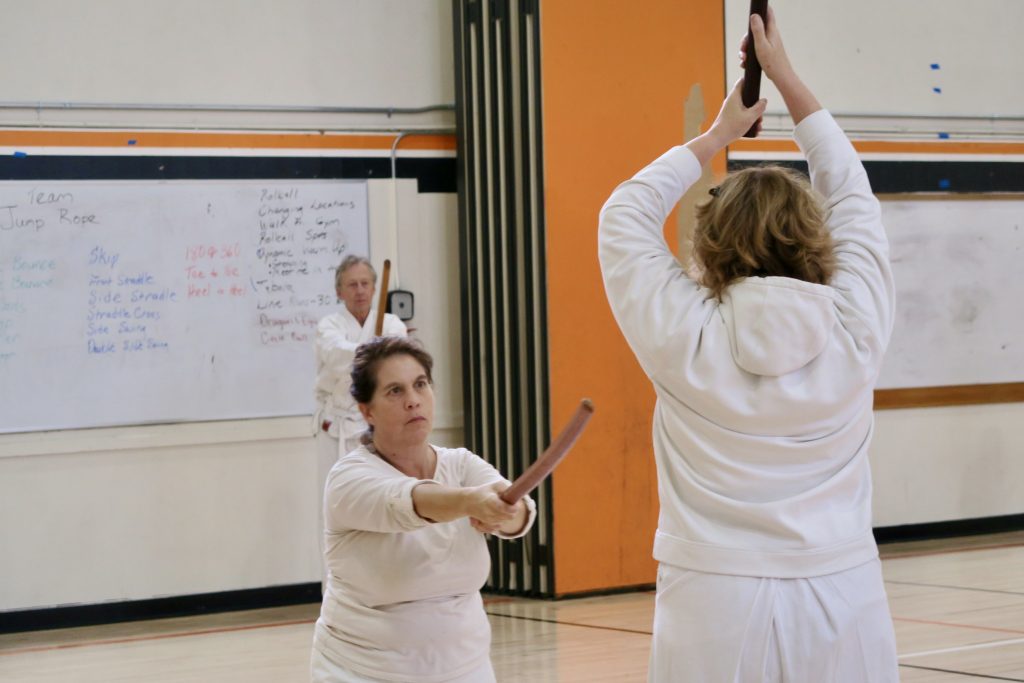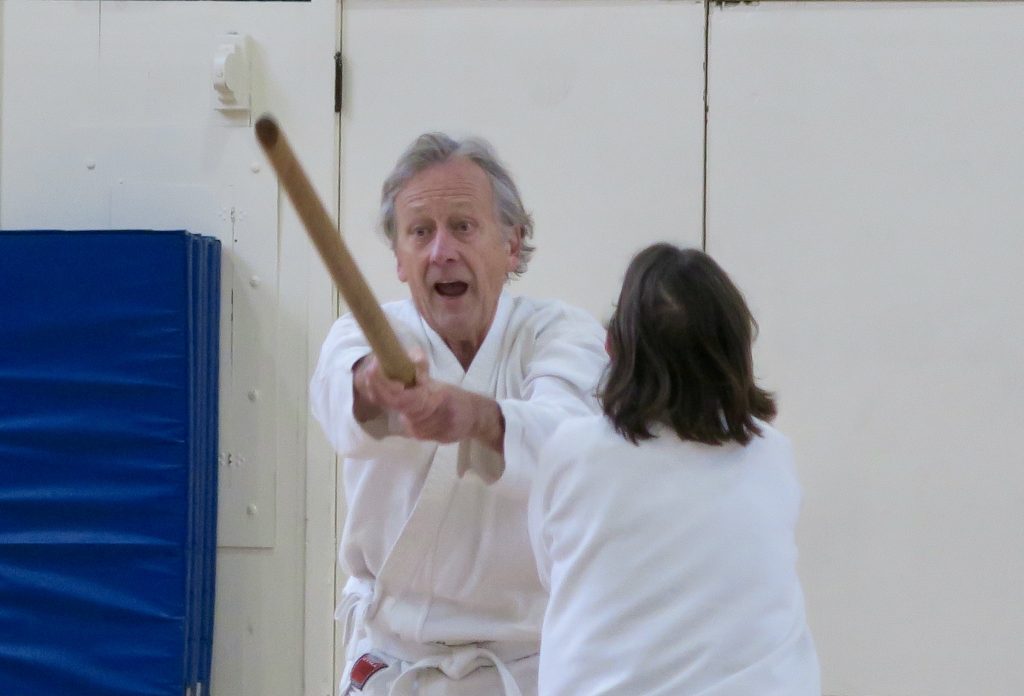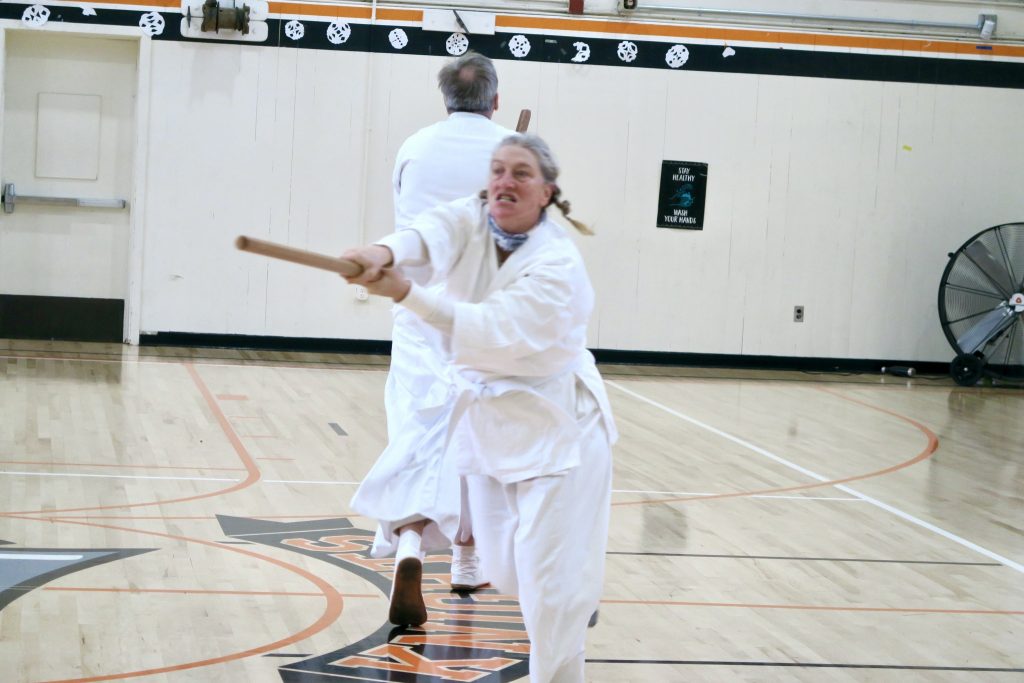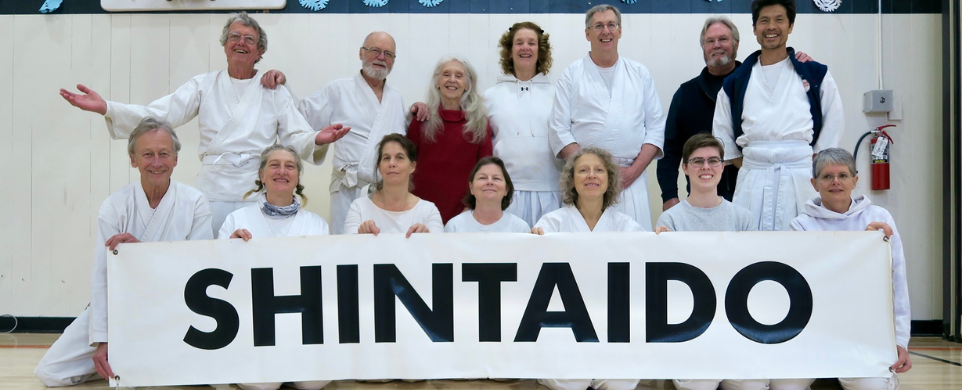By Derk Richardson
It had been three years since Pacific Shintaido was able to host its annual Kangeiko gathering in person. But, after two years of surprisingly successful virtual workshops, with participants from all over North America and Europe interacting via Zoom, Shintaido practitioners came together over the Martin Luther King Jr. holiday weekend to explore the theme Hei Ho: The Strategy of Fighting, the Strategy of Peace. On Saturday, January 14, and Sunday, January 15, four keikos were held in the gymnasium at Claremont Middle School in Oakland.
General Instructor Connie Borden and Senior Instructor Rob Gaston accepted the invitation by the Pacific Shintaido Board—Shin Aoki, Cheryl Williams, and Derk Richardson—to serve as guest instructors for Kangeiko 2023. Both hold Yondan ranking in kenjutsu, which was the general subject for the workshop. The specific theme, Hei Ho: The Strategy of Fighting, the Strategy of Peace, was inspired by a 2020 interview with Master Instructor Masashi Minagawa (published in Body Dialogue on November 6, 2022). In his opening ceremony remarks, Derk quoted Minagawa Sensei’s comments on Kangeiko (“we refresh our old selves and go back to the original beginner’s mind”), Kenjutsu (“The sword can be used as a tool or compass which can show us how to manage our lives, it can show us which direction to follow”), and the concept of Hei Ho. “The word Hei Ho 兵法 … means the Strategy of War. If Hei is written differently [using another Chinese character 平] it can also mean Strategy of Peace 平法.… Therefore, there are two ways of studying martial arts, the way of war and the way of peace.”

Before we began warmups, led by Director of Instruction Shin Aoki, Rob Sensei led us in an exercise to help set our intention for both Kangeiko and the coming year. He asked the ten attendees to offer up words that spontaneously came to mind when we thought about achieving peace in the world. Responses included “love,” “empathy,” “compassion,” “forgiveness,” “community,” “diversity,” and more. Rob Sensei urged us to fold those thoughts into our intention and hold that intention throughout the workshop.
After warmups, Connie Sensei led us in several sets of Reppaku, two linked movements in Taimyo kata. Drawing fists to hips, we opened palms and extended them forward while taking a right hangetsu step. Then, bringing feet together and the backs of our hands together at the chest, we reached up overhead, twisted our hands back, and cut forward and out while taking a left hangetsu step. Connie Sensei offered the images of emptying our pockets, lightening our loads, letting go of the burdens we carry, and spreading the seeds of intention, and then flying up and opening out to see the view before us. After a couple of repetitions, we were encouraged to find our own inspirations and images as we repeated the movements.
For the next hour, Rob Sensei led us in kiri-oroshi kumite, a partner cutting and opening technique, keeping in mind the goals of reconnecting and establishing a physical and spiritual conversation. Keiko one concluded with Rob Sensei leading us in Hoten Kokyu Ho, the gentle kata of embracing the great universe, bowing, embracing the tiniest universe, and rising up again. Those of us familiar with the poem Rob Sensei had written to correspond with the movements might have envisioned expanding our awareness from ourselves to others, to greater communities and cultures, to nature, the biosphere, and cycles of birth and death, and to the solar system, galaxies, and black holes, acknowledging that we are made of stardust and the universe is in us, and finally expanding our awareness to Ten and rising up to Ten Chi Jin.

The next three keikos were dedicated almost entirely to kenjutsu, with participants using bokuto or, in some cases, bokken. Connie Sensei and Rob Sensei taught alternating segments of the curriculum they have developed together. On Saturday afternoon, after Sandra Bengtsson led warmups, Connie led us through stepping practice with bokuto—steps number one through four, plus irimukae, holding the bokuto in a vertical position close to the body and doing step number one, as if stepping into one’s sword. Rob Sensei guided us in sword-drawing techniques and in practicing the transitions between shoko and tenso. And Connie Sensei gave us instruction in bokuto kumite, dai jodan versus jodan, demonstrating with Rob Sensei and adding new partner pairings until all participants were doing the kumitachi. Keiko number two ended with 15 minutes of open-hand Tenshingoso kumite.
Keiko number three, on Sunday morning, began with Connie Sensei leading a freeform style of warmups with the aim of dissolving the roles of leader and follower, emphasizing listening, softening, releasing, and achieving fluid movement. Rob Sensei reviewed the previous afternoon’s kumitachi, which we practiced with different partners and many repetitions. Connie Sensei introduced one-hand Tenshingoso kumite, with one partner responding to the other’s four Tenshingoso movements, cultivating a tight, elastic “ma.” We did the same in two lines of partners facing each other, one side leading and the other responding, moving together in a chorale. In the end, practitioners in both lines did all four Tenshingoso movements, the lines flowing back and forth like ocean waves. Ten minutes of Wakame brought the keiko to a close.

For the last of the four keikos, after Derk led 30 minutes of warmups, we continued with our kenjutsu practice. We divided into two groups. One person stood in the middle, sword raised in tenso. One by one, the others stepped forward quickly and cut the stationary person with jodan kiri komi. Each practitioner took a turn in the center. Our final sword practice was eiko dai kumite, dai jodan versus jodan kiri komi. It started with Connie Sensei and Rob Sensei. Then it became a rotation until everyone had participated. The last few pairings became more free-flowing and continuous. The keiko closed with Connie Sensei leading us in another movement from part one of Taimyo kata, Sai-Zan, “breaking through mountains.” She has reflected deeply on this movement’s relationship to the practice of death awareness, an analog to an army’s retreat, in focused concentration, without fear. But, as a coda to our Kangeiko curriculum, it felt more like an affirmation of life and of our collective intention to move forward with what we had learned.
Overall, the kenjutsu curriculum that Connie Sensei and Rob Sensei created for Pacific Shintaido’s Kangeiko 2023 was fairly basic—simple, foundational movements with a lot of repetition and opportunities to practice with different partners. For those practitioners with less kenjutsu experience, it provided an opportunity to develop muscle memory and inhabit the form. For more senior practitioners, it opened up the space to go deeper into their relationship with the sword—bokuto or bokken—and explore the meaning within. For all, there was an exhilarating suffusion of tenso feeling. We thank Connie Sensei and Rob Sensei, and participants from the greater Bay Area and from Florida, for making Kangeiko an expanded moment of self-refection and enhanced connection with our fellow Shintaido “beginner’s mind” practitioners, the human community, and the universe.




Thank you Derk. It was a honor to be invited.
Thank you Derk and all Pac. Shin. It was a joy for me to get this opportunity to share my and Connie’s ideas and practice.